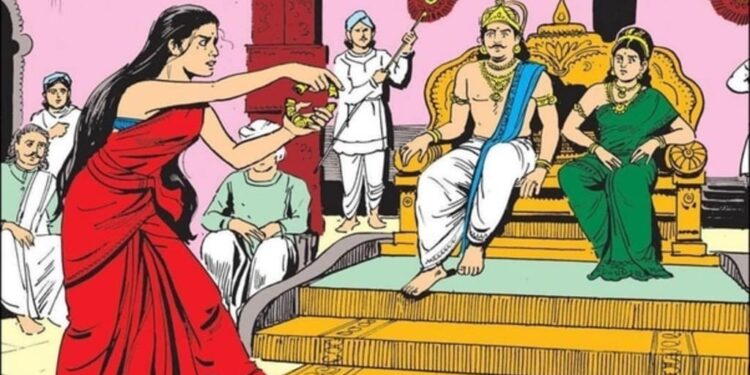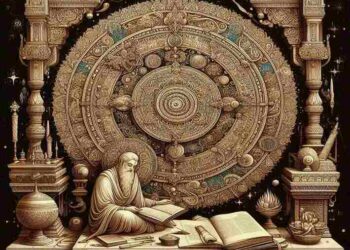Introduction
Cilappatikaram: An Anklet Story Summary and Themes One of the five great epics of Tamil literature, Cilappatikaram (சிலப்பதிகாரம்), was written in the second century CE by the poet Ilango Adigal.
It is frequently translated as The Tale of an Anklet. This epic combines social criticism, romantic tragedy, and mythological storytelling.
It is a profound cultural classic that offers profound insights into Tamil society and religious customs of the day, in addition to being a lovely tale of love, grief, and retribution. It is still influencing literary traditions today and is considered by many to be a masterpiece of Tamil literature.
The main character of the story is Kannagi, a loyal wife whose tragedy and tenacity lead to the fall of a kingdom. With elements of dharma (righteousness), karma (action and consequence), and the function of justice, Cilappatikaram’s story falls into a number of genres, including drama, romance, and moral tale.
Summary of Cilappatikaram
The story of Cilappatikaram unfolds in three books: the “Poompuhar” (The City of Poompuhar), the “Madurai” section, and the conclusion that deals with Kannagi’s curse.
The First Book: The City of Poompuhar
The epic begins with the birth of Kannagi and the context of her marriage to Kovalan, a prosperous merchant. They live happily in the city of Poompuhar, enjoying a life full of love and contentment. Kovalan, however, is a man of indulgence, which leads him astray.
His infatuation with the courtesan Madhavi, a dancer, is a turning point in the story. Despite Kannagi’s devotion and virtue, Kovalan’s fall into temptation causes his wealth and status to deteriorate.
Kovalan’s affair with Madhavi is short-lived, and he realizes his mistake. He returns to Kannagi, but by now, their former life is beyond repair. Kannagi’s patience and loyalty, however, never wavers. With her moral strength and love, she forgives Kovalan’s past indiscretions and prepares to start afresh.

The Second Book: The Tragedy at Madurai
After returning to Kannagi, Kovalan decides to leave Poompuhar and visit the city of Madurai to begin a new life. In Madurai, Kovalan starts a new venture, and in the process, he visits the royal jeweler’s shop, where he buys a pair of precious anklets for Kannagi.
A mistake occurs when Kovalan is accused of stealing the queen’s anklet by the king’s ministers. The king of Madurai, Pandya, initially condemns Kovalan without investigation, influenced by the deceit of his chief minister.
Despite Kannagi’s impassioned plea for justice, the king, under the wrong assumption, orders Kovalan’s execution. This is the turning point in the epic, and it marks the tragic downfall of Kovalan. Kannagi, devastated by the wrongful death of her husband, demands justice and expresses her fury through a public demonstration of her loyalty and love for Kovalan.
The Third Book: Kannagi’s Curse and the Fall of Madurai
Kannagi, devastated and enraged, accuses the king of Madurai for his injustice and curses the city. She declares that Madurai will be destroyed and that the king will face divine retribution. In a dramatic sequence, Kannagi opens the anklet she had received from Kovalan, revealing that it was the queen’s anklet that Kovalan had bought, leading to the realization of the royal mistake.
As Kannagi curses the city, Madurai faces a calamity—fire consumes the city, and destruction spreads. Eventually, the king realizes the tragic mistake he has made, and the city’s downfall becomes an embodiment of justice being served through divine intervention.
Cilappatikaram: An Anklet Story Summary and Themes In the end, Kannagi’s grief is juxtaposed with her divine resolve. She does not ask for vengeance but merely seeks justice for her slain husband. Her curse serves as a poignant reminder of the consequences of unrighteousness and the power of a woman’s virtue and anger.
Themes in Cilappatikaram
The central themes of Cilappatikaram revolve around justice, love, suffering, and the role of women in society. These themes are not only relevant to the time in which the epic was written but also have an enduring impact on modern literature and society.
1. Justice and Karma
Cilappatikaram: An Anklet Story Summary and Themes At the heart of Cilappatikaram is the theme of justice and karma. Kovalan’s wrongful execution represents the tragic consequences of injustice. The fact that Kannagi’s plea for justice is ignored by the king symbolizes the moral decay of the kingdom.
However, her curse serves as a cosmic balancing force, restoring righteousness by causing the king and the city to face divine retribution. The theme of karma is further exemplified in the eventual destruction of Madurai, as it was built upon false accusations and unethical behavior. The laws of nature—the forces of dharma (righteousness) and karma—are depicted as ultimately more powerful than human law.
2. The Power of Female Virtue
Kannagi, as the central female character, embodies the power of female virtue and devotion. She is portrayed as an ideal wife, unwavering in her loyalty and love for her husband. Her actions highlight the moral strength and integrity of women in the epic. Kannagi’s devotion and sacrifice for Kovalan are unwavering, even in the face of his betrayal. Yet, her anger is justified when the kingdom fails to uphold justice for her wronged husband.
Moreover, Kannagi’s ultimate curse on Madurai marks a unique moment in literature where a woman’s virtue and anger bring about significant change. Her actions are not driven by a desire for revenge, but by the need to restore justice and balance. This theme resonates deeply with the social context of ancient Tamil society, where women’s roles were often confined, yet Kannagi transcends these limitations by asserting her agency.
3. The Role of Fate and Divine Intervention
Cilappatikaram: An Anklet Story Summary and Themes The theme of fate and divine intervention is pervasive throughout the epic. The death of Kovalan and the subsequent destruction of Madurai suggest that certain events are predestined, and divine powers are often at play to restore cosmic balance.
Kannagi’s curse, as an act of divine will, brings about a calamity, ensuring that the kingdom faces the consequences of its wrongdoings. Divine justice, however, does not occur immediately but unfolds through a series of tragic and poignant events. This theme is an essential part of Tamil epic literature, where divinity intervenes in human matters when moral law fails.
4. The Conflict Between Love and Loss
Cilappatikaram: An Anklet Story Summary and Themes Cilappatikaram portrays a complex narrative about the tension between love and loss. The first part of the epic, which showcases the bliss of Kovalan and Kannagi’s marriage, is marked by deep affection and mutual respect.
The subsequent loss of Kovalan and the unraveling of Kannagi’s life represent the emotional depth of this epic. However, it is also a story of recovery and empowerment. Kannagi’s journey from grief to retribution demonstrates her personal strength and the vindication of her love. The emotional turmoil of loss is counterbalanced by a powerful sense of justice and righteousness.
5. Social and Cultural Critique
Cilappatikaram also critiques social norms and practices, particularly regarding issues like adultery, justice, and gender roles. The treatment of women in the epic is layered, showing how women were expected to embody virtue but were also subjected to harsh societal judgment. Kovalan’s initial infidelity reflects the fragility of human relationships, while Kannagi’s tragic fate underscores how a woman’s virtue and loyalty can be tested in an unjust world.

Conclusion
Cilappatikaram: An Anklet Story Summary and Themes With timeless resonance, Cilappatikaram is a profound examination of justice, love, and divine intervention. Its philosophical and moral insights still have an impact on Tamil literature as well as India’s broader cultural legacy.
One of the most timeless tales of feminine courage, dedication, and the victory of virtue against injustice is the story of Kannagi. The epic offers timeless teachings about justice, karma, and the intricacies of interpersonal relationships by deftly fusing romantic tragedy with social critique.
Cilappatikaram: An Anklet Story Summary and Themes Fundamentally, Cilappatikaram is a larger commentary on the nature of morality and human fallibility rather than merely the story of a woman who is harmed.
The epic serves as a potent reminder of the importance of integrity and morality in the face of hardship through Kannagi’s unshakable dedication to justice. The story’s fitting climax is Madurai’s annihilation, which is a cosmic corrective brought about by the unwavering spirit of truth and love.
Read more
FAQ
1. Who is the author of Cilappatikaram?
The author of Cilappatikaram is Ilango Adigal, a legendary Tamil poet who is believed to have belonged to the royal family of the Cheras. He is credited with composing the epic, which is one of the five great Tamil epics.
2. What is the significance of Kannagi’s anklet?
The anklet, which is the object around which the entire plot revolves, symbolizes fidelity and virtue. It is a gift from Kovalan to Kannagi, and it serves as the evidence that clears Kovalan’s name and reveals the wrongdoing of the king. The anklet also represents the sacred bond between husband and wife, and its significance is central to the theme of justice in the epic.
3. What are the moral lessons of Cilappatikaram?
Cilappatikaram imparts several moral lessons, including the importance of justice, the power of women’s virtue, and the consequences of wrongdoing. It also explores the idea that karma dictates the events in one’s life, and that divine intervention can help restore balance in society when human justice fails.
4. How does Cilappatikaram address issues of gender?
Cilappatikaram portrays a strong female protagonist, Kannagi, whose moral strength, loyalty, and sacrifice highlight the central role of women in the epic. While Kannagi embodies ideal womanhood, the story also critiques societal attitudes toward women, as her virtue is tested by the actions of men, including her husband’s betrayal and the king’s failure to uphold justice.
5. What is the significance of Madurai’s destruction in the epic?
The destruction of Madurai symbolizes the divine retribution for the king’s failure to deliver justice to Kovalan. It reinforces the epic’s central theme of karma, showing that when human law fails, divine forces will intervene to restore balance and right the wrongs.
















